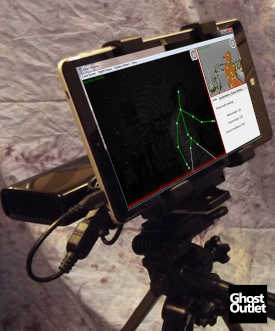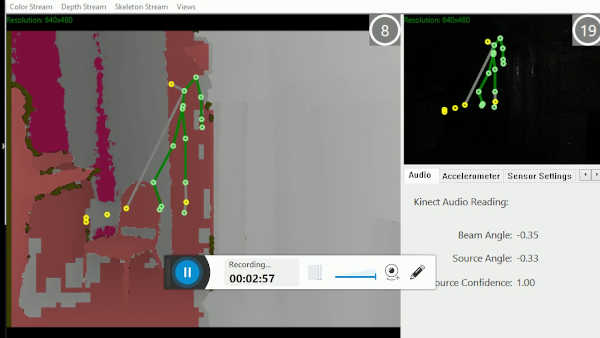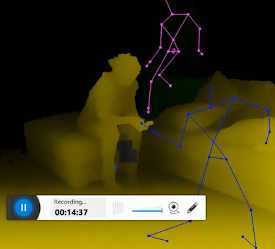|
SLS Camera - Structured Light 3D Scanner
Written by Mark Stinson - Ghost Vigil Investigations
|
In the simplest terms, a structured-light 3D scanner is a 3D scanning device for measuring the three-dimensional shape of an object using projected light patterns and a camera system. The camera works by projecting its own invisible infrared laser grid over a wide field of view. The grid is formed from a million tiny dots which allow the SLS Camera to capture a representation of 3D space. It "sees" shapes using this grid of dots, rather than using visible light. It measures the distance between the infrared dots, creating a 3D model of what it is viewing.
Because the 3D model is formed of dots, if anything moves the camera recognizes the change in the distance between the dots, and sees these changes as movement. You have to know the history of the technology in order understand how and why some paranormal investigators use the device in field investigations. The SLS camera was widely used in Kinect devices on the Xbox 360 video game console, and later the Xbox One. The Kinect was designed to allow players to use motion controls to navigate through their console's menus and interact with Kinect compatible games. So, these SLS systems were designed to recognize, identify, and lock onto the human form.
|
|
 |
Most SLS camera set-ups used by paranormal investigators are built using first generation SLS systems from the early Kinect devices. These first generation systems are modified to operate off of battery power, and are then combined with a camera, a view-screen, and some are even paired with a heat-sensing camera. So like so many other devices used by paranormal investigators, SLS cameras were designed for a very specific purpose, but in the field investigators are using them for an entirely different purpose.
What Popularized these Devices Among Investigators?
It is hard to track exactly when the SLS camera crossed over from video game accessory to paranormal investigation tool. But, it is widely believed that the spark for the idea came from the movie Paranormal Activity 4, wherein a character in the movie combined a Kinect with an infrared camera in order to the ghost of a young boy. In the movie, no one could see the ghost, but the improvised Kinect device allowed the ghost to be seen.
Its not known what gave the writers of Paranormal Activity 4 this idea, but it could be the fact that Xbox owners with a Kinect were often a little disconcerted when their Kinect would identify something in the room with them as a person, when they were actually alone in the room. The simple explanation for this odd malfunction, is that the Kinect algorithm responsible for identifying the human shape from a million little dots of infrared light, was interpreting, or "seeing," in its 3D reconstruction of the space a shape that it misidentified as a human form.

Essentially, this is a software glitch. Though, one could argue that the algorithm is not glitching, as much as looking for 3D markers similar to the human form, and doing its job the best it can. Regardless, many gamers suggested (some jokingly) that the Kinect was identifying ghosts in the room with them. Is this where the idea came for its use in Paranormal Activity 4? This is unknown.
The SLS software and agorithm are limited in their ability to identify the human form. Anyone who has owned an Xbox with a Kinect device knows this. Sometimes it identifies things as human, that are not human. And it sometimes fails to identify human forms that are standing in clear view of the camera. Sometimes it things you your head is your hand. Like all such technology, it has its limitations and does not always work as intended.
Among paranormal investigators, Bill Chappel is most often credited with building the first SLS camera set up for use in paranormal investigations. He created the device for Zak Baggans on the Travel Channel's "Ghost Adventures" television show. And the device has picked up steam from there.
Issues with Use of an SLS Camera
The SLS camera creates a stick-figure on the view screen where it has identifed a "human form." The stick-figure has knees and elbows and other joints, and this was obviously designed for the useful purpose of allowing an Xbox game console to know where its user is located and how he/she is moving.
When used on paranormal investigations, the investigator often walks around the investigation site with the SLS camera in hand. When a stick-figure appears on the view-screen, but there is no living human in that position, this is often taken as identifying a ghost in the environment. Unseen by the traditional camera and the eyes of the investigators, but detected by the SLS grid of infrared dots and drawn on the screen as a stick-figure.
There are several problems with making this conclusion.
|
We've already discussed that SLS technology and the algorithms that attempt to identify the human form can create false positives. It can identify human forms that aren't there, and it can fail to identify human forms that are actually present. This occurs for several reasons. As the software reconstructs 3D space with a million infrared dots, it can simply misidentify certain shapes as being human that are not human. What accerbates these errors, is carrying the camera around. Carrying the camera means its view is contactly moving, and this can easily be misinterpretted by the software as the objects in its view moving.
The Kinect and technologies like it, were meant to sit on a table or entertainment center in front of your game console. They are meant to be stationary, with a stationary view...and to identify objects moving in its view.
|
|
 |
Having the Kinect mobile and its view constantly moving, will of course make the algorithm's job more difficult. The viewpoint is moving, so the Kinect might misidentify objects as moving, and then in turn misidentify this as human movement in the right circumstances.
As with all optical sensing or scanning methods, translucent or reflective surfaces can affect the SLS camera's ability to accurately construct a model of 3D space. In addition, the SLS camera has an effective range of about 3 meters. Out beyond this distance, the camera is even more likely to mistakenly read the 3D space it is scanning.
When you combine algorithm limitations, using the camera on-the-move, surfaces not conducive to scanning with infrared dots of light, and using the camera without a clear idea regarding range limitations...the SLS is sure to produce false positive identifications of human forms that are simply mundane errors.
The Real Problem
Let's for a moment forget about all the existing causes of false positives inherent with SLS cameras. The real problem here is a lack of explanation for how infrared dots could possibly "see" a ghostly form that an infrared camera does not see. By what mechanism does one explain its ability to see what no other device can see?
Despite what one might think ghosts are made of or exactly how they manifest, it is very problematic to conclude that infrared dots of light can "sense" a ghost while an infrared camera shooting out and recording infrared light from the same viewpoint cannot "sense" it. There is nothing special about the infrared light that an SLS camera employs to reconstruct a model of 3D space.
Additionally, there is no controlled way to show that when an SLS camera "detects" a human-form where no living human is standing, that it is sensing a ghostly form. We can't generate a ghostly form on demand in order to ensure that the SLS camera can detect one. It was designed to identify humans and movement, and it was not (and cannot) be designed to detect ghosts.
Without a working theory for how the SLS camera produces results that an infrared camera cannot, it is hard not to conclude that every human-form-detection made by the camera in cases where no human is present is a false positive result.
False Positives Can be Compelling
If you watch a few "ghost investigations" on YouTube where they are using an SLS camera, or you google some SLS camera footage featuring a human-form-detection, you will see some interesting footage. Stick-figures dancing and contorting in empty space in the camera's view. You'll also notice how the proportions of the stick-figures are often completely in-human. The stick-figures flicker on and off screen and they are often configured in awkward or distorted poses. They climb up walls and end up on the ceiling. If one is being generous, one might conclude that ghostly forms do not come in strictly human proportions, that they can be distorted or awkward, that they come and go easily, and can fly up to the ceiling.
But, if one were being a little more skeptical, one might suggest that the strange proportions and distorted stances are the result of the algorithm attempting to make sense of the movement and possible human-form it has falsely identified from the million dots of infrared light it is using to construct a model of 3D space. This is made even more clear when instead of a stick-figure, the camera creates a jumbled mess of lines as the algorithm attempts to work through data it is having trouble processing.
These same on-line videos often feature investigators reacting excitedly to the results the SLS camera is producing. You'll see the thrill of finding something. You'll see fear. You'll see, generally, a lot of emotion generated among the investigators watching the view-screen of the SLS camera. And watching these videos is compelling, and entertaining, and definitely gives the impression that the investigators are detecting actual ghosts. Excitement and entertainment generates viewship and clicks.
As with other problematic technologies employed in paranormal investigations, the more likely a false positive, the more popular the technology. Let that sink in a minute. The more likely and more often a false positive is produced, the more likely that the technology in question will be used on television ghost-hunting shows and by paranormal investigators in the field. |
|
 |
We've seen this with EMF detectors. We've seen it with powerful microphones and audio filtering software in EVP work. We've seen it with photographic orbs (dust and particulates in the air) being interpretted as a paranormal event. And, I'd predict that SLS technology will become even more popular among paranormal investigators, with little thought to how common false positives are when using this technology.
Would Ghost Vigil Investigations Use an SLS Camera?
As always, this article was not written to insult or offend anyone. It is important to understand the technology we are using. It is important to understand its capabilities, its limitations, and its pitfalls. If we can't have an honest conversation about these things, then how will we ever approach the truth?
The short answer to the question, is Ghost Vigil will be working with an SLS camera in the near future. We'll be putting it through its paces, and testing the equipment to see when it works and when it doesn't work. Can we generate false positives in environments we believe to be free of paranormal activity? Can we create false positives repeatedly, and predictably, using very specific methods?
We also intend to use an SLS camera on investigations at historic locations known to be haunted. But, we'll be going into this with our eyes wide open, knowing the device's proclivity to create false positives.
But, we believe it would be irresponsible to use this technology during private residence and business investigations where a client has called us for help with possible paranormal activity. If the client becomes aware that the SLS camera is "identifying" human-forms where no living human is standing, rolling that back, and trying to explain false positives to a client would be very difficult, if not impossible in some cases. There is a real danger of the client coming away from the investigation with a false impression of what was discovered in their home.
|







